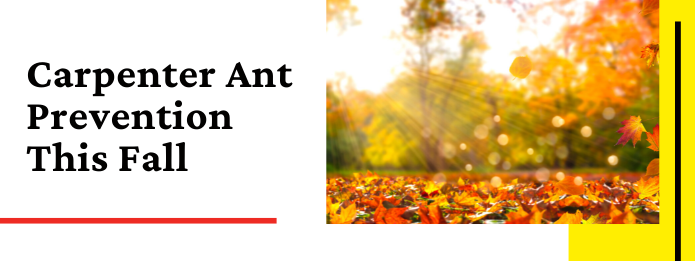
Carpenter ants use their strong front jaws to chew tunnels through wood to make their nests. In the wild, this helps the decaying stumps of fallen trees to break down more quickly. Therefore, as long as carpenter ants stay outside where they belong, they are actually beneficial. However, if they start building their tunnels in the wood of your home, it can cause extensive property damage. Prompt carpenter ant removal can avoid expensive repairs later.
Nevertheless, it is vastly preferable to prevent carpenter ants from getting into your home in the first place, which is easier if you understand their habits. Carpenter ants may be more active looking for a new place to build a nest in the fall.
Why Are Carpenter Ants More Active in the Fall?
While carpenter ants are active in the summer, the hot temperatures can be hard on them. Carpenter ants prefer cool temperatures, so as the weather outside becomes chillier with the approach of autumn, they become more active. In some areas, fall also sees more precipitation, and carpenter ants prefer damp weather as well.
In many cases, when carpenter ants are active in the fall, they are looking for a place to shelter from winter weather and start building a new nest. They prefer to tunnel through wood that is soft and easy to chew through. Wood that is mouldy, rotted, or damp serves their purposes well.
When carpenter ants live outside, they go dormant during the colder months. However, if they build a nest inside a home where the temperature remains warm through the winter, they remain active all season. This being the case, they need easy access to food and water, and a human habitation can provide that as well. Because the ants remain active, they can stay hard at work building their nest all winter long, and that means more potential damage to your home.
What Can You Do To Prevent Carpenter Ant Infestation?
As the seasons start to shift from summer to fall, you should check around your home for entry points by which ants could get in. Pay attention to the following areas:
- Holes in weather-stripping
- Gaps around wires and pipes
- Gaps around window frames and door frames
- Cracks in the foundation
While carpenter ants are capable of chewing their way into your home, they prefer not to if there is an easier way to get in.
If there is any damp or mouldy wood around your property, it should be removed and replaced. Pay particular attention to the siding on your home, as well as the baseboards. If you have a woodpile, stack it as far away from your house as possible and only bring the wood inside when you need it. Elevate it off the ground and try to protect it from moisture.
In autumn, the leaves on the trees fall down and cover the ground, interfering with evaporation from the soil. Moist ground attracts carpenter ants, and the leaves also provide cover for them. Therefore, you should rake them up or clear them away as soon as possible. You should also clean leaves out of your gutters because otherwise, they could cause clogs. Clogged gutters allow water to spill onto the wood of your home and the ground near the foundation, creating conditions conducive to a carpenter ant infestation in either case.
When Should You Call for Carpenter Ant Removal?
One carpenter ant in your home isn’t necessarily a reason to panic, but keep your eyes peeled for more. If you see multiple carpenter ants, you should call Truly Nolen for pest control in Waterloo right away. Carpenter ants in your home mean that they have a nest nearby and are likely working tirelessly at expanding it, doing more property damage in the process.
